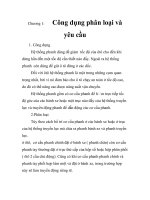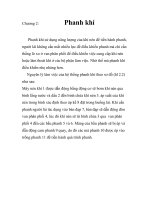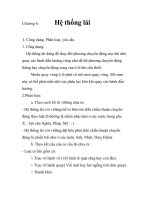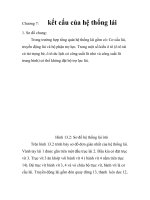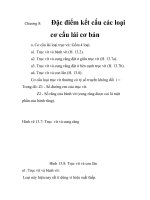Bảo dưỡng và sửa chữa (maintain and repair mechanical drives and mechanical transmission assemblies)
Bạn đang xem bản rút gọn của tài liệu. Xem và tải ngay bản đầy đủ của tài liệu tại đây (2.88 MB, 151 trang )
Fitting & Machining
Version: October 2008
MEM18007B
Maintain and repair mechanical drives and
mechanical transmission assemblies
Reference Book
UNIT 18007B – MAINTAIN & REPAIR MECHANICAL DRIVES & MECHANICAL TRANSMISSION ASSEMBLIES
UNIT: 18007B – Maintain and repair mechanical
drives and mechanical
transmission assemblies
The State of Queensland (TAFE Queensland) 2002
Copyright protects this publication. Except for purposes permitted by the
Copyright Act, reproduction by whatever means is prohibited without the prior
written permission of TAFE Queensland. Inquiries should be addressed to the
Librarian (Copyright), Library and Information Management Services, Open
Learning Institute of TAFE, GPO box 1326, Brisbane Q 4001.
Edition :
1
April, 2002
Template Version 5, April, 2002 by N. F. Lassen, Mount Isa Institute of TAFE,
PO Box 1612 Mount Isa Queensland, 4825
Acknowledgments:
Acknowledgments:
Unit Writer:
N. F. Lassen, B. Teaching (FET);
Cert.IV in Workplace Training &
Assessment; Trade Qualified; Cert
III InfoTech; MERSITAB Reg.
Assessor; Teacher, Mt Isa Institute
of TAFE
Unit Editor/Moderator:
C. N. Leader, B. Ed; Dip.Eng; Trade
Qualified; BB; ES; Cert.IV in
Workplace Training & Assessment;
MERSITAB Reg. Assessor; Principal
Teacher, Wide Bay Institute of TAFE
Moderators Signature:
C N Leader
Date:
PAGE 2
UNIT 18007B – MAINTAIN & REPAIR MECHANICAL DRIVES & MECHANICAL TRANSMISSION ASSEMBLIES
Unit contents
Page
Unit contents......................................................................................................................3
Unit: 18007B – Maintain and repair mechanical drives and transmission assemblies .....5
Pre-requisites ................................................................................................................5
Resource Materials .......................................................................................................6
Introduction...................................................................................................................6
Range statement............................................................................................................8
Assessment....................................................................................................................8
About the Icons...........................................................................................................11
Check your current knowledge ...................................................................................11
Section 1 – Friction Belts ................................................................................................13
Introduction.................................................................................................................14
Characteristics of belts................................................................................................15
Flat belts......................................................................................................................16
Vee Belts.....................................................................................................................19
Timing or synchronous belts ......................................................................................23
V-ribbed belts .............................................................................................................23
Belt and pulley installation .........................................................................................25
Checklist .....................................................................................................................40
Summary.....................................................................................................................40
Section 2 – Working with gears and Gear drives ............................................................41
Introduction.................................................................................................................42
Introduction to gears ...................................................................................................42
Gear terminology ........................................................................................................47
Worm and Worm Gears ..............................................................................................51
Checklist .....................................................................................................................68
Summary.....................................................................................................................68
Section 3 – Chain drives..................................................................................................69
Introduction.................................................................................................................70
Precision roller chain ..................................................................................................71
Types of chain.............................................................................................................71
Joints and spare parts ..................................................................................................73
Chain pinions and chain wheels .................................................................................77
Installation and maintenance of chain drives..............................................................78
Methods of chain lubrication ......................................................................................87
Checklist .....................................................................................................................92
PAGE 3
UNIT 18007B – MAINTAIN & REPAIR MECHANICAL DRIVES & MECHANICAL TRANSMISSION ASSEMBLIES
Summary.....................................................................................................................92
Section 4 – Clutches, brakes and couplings ....................................................................93
Introduction.................................................................................................................94
Purpose of couplings...................................................................................................95
Installation and maintenance of couplings ...............................................................106
Clutches ....................................................................................................................114
Brakes .......................................................................................................................120
Checklist ...................................................................................................................129
Summary...................................................................................................................129
Section 5 – Shaft, drives and coupling alignment .........................................................130
Introduction...............................................................................................................131
Types of misalignment..............................................................................................132
Types of misalignment..............................................................................................133
Principles and methods of Alignment.......................................................................134
Soft foot ....................................................................................................................137
Aligning pulleys........................................................................................................138
Laser belt aligning tool .............................................................................................141
Aligning chain drives................................................................................................143
Symptoms of misalignment. .....................................................................................144
Checklist ...................................................................................................................150
Summary...................................................................................................................150
PAGE 4
UNIT 18007B – MAINTAIN & REPAIR MECHANICAL DRIVES & MECHANICAL TRANSMISSION ASSEMBLIES
Unit: 18007B – Maintain and repair
mechanical drives and
transmission assemblies
Welcome to Unit 18007B, which is a stream unit of the National
Metal and Engineering Industry Competency Standards. This unit
is designed to help you understand the maintenance and repair of
a range of mechanical power transmission and drive components
and/or assemblies.
This Study Guide is designed to guide you through the unit and
assist in planning your study. It is written in a self-paced format
that will allow you to progress through at your own speed and
convenience. It is structured to assist you in obtaining the
necessary knowledge and skills required for this unit of
competency.
For further information you should refer to the Range
statement on page 3
Pre-requisites
You should have completed prior to this unit or be doing
the following units concurrently with this unit:
9.1A – Draw and interpret sketch
9.2A – Interpret technical drawing
18.1A – Use hand tools
18.2A - Use power tools, hand held operations
18.3A – Use tools for precision outcomes
18.6A – Dismantle/repair/replace/assemble engineering
components
18.9A – Levelling and alignment of machines and
engineering components
PAGE 5
UNIT 18007B – MAINTAIN & REPAIR MECHANICAL DRIVES & MECHANICAL TRANSMISSION ASSEMBLIES
Resource Materials
This study guide recommends these texts to further the topics
covered:
Fitting and Machining, Edited by Ron Cully
Principles of Machine Operation and Maintenance, by Dick
Jeffrey
Introduction
The study guide is divided up into a number of sections with
Activities to work through. These Activities when successfully
completed will build towards competency. Each section is
further divided into a number of related Topics. What you
will cover is presented at the beginning of each section.
Take the time to work through the various Activities that are
included to build on your knowledge and skills. They will also
help to assess your current level of knowledge and to decide
how much time and effort to spend on each part.
The table on the page 5 shows how the Activities you
need to complete in this study guide relate to the
Criteria in the Unit that will be used in your
assessment. The Activities may also relate to
practical tasks used to assist in developing both
your underpinning knowledge and skills relevant to
this Unit. It is recommended that you become
familiar with this table. You should refer to the
Competency Unit in your training record book or in
the appendices of this study guide for additional
information if necessary.
PAGE 6
UNIT 18007B – MAINTAIN & REPAIR MECHANICAL DRIVES & MECHANICAL TRANSMISSION ASSEMBLIES
The following elements and their associated criteria
requirements are covered in this Study Guide:
Element 18007B.1 – Undertake maintenance of mechanical
drives and mechanical transmission
assemblies
Element 18007B.2 – Adjust mechanical drives and
transmission assemblies
Element 18007B.3 – Diagnose faults
Element 18007B.4 – Repair mechanical
drives/transmissions
Element 18007B.5 – Final adjust and commissioning
The information provided here covers the underpinning
knowledge you will require when final workplace assessment
takes place.
Only when you have successfully completed both the
underpinning knowledge and Activities contained in this
Study Guide and any necessary final workplace
assessment if required, will you be deemed competent in
this unit.
Remember: If you need assistance ask! Contact your
Teacher/Trainer and/or RTO at any time.
PAGE 7
UNIT 18007B – MAINTAIN & REPAIR MECHANICAL DRIVES & MECHANICAL TRANSMISSION ASSEMBLIES
Range statement
Work undertaken autonomously or in a team environment using
predetermined standards of quality, safety, and workshop
procedures involving the adjustment, repair, replacement of
mechanical drives/transmission assemblies and associated
components. Drive devices may include worm and worm wheel,
line shafts, plumber blocks, pulleys, sprockets, belts, taper bush
assemblies, roller chains, chain drives, mechanical and hydraulic
couplings, compression couplings, disc type flexible couplings,
spider type, chain couplings, universal joints, bevel gearing, rack
and pinion gearing, dog toothed clutches, cone type clutches,
friction/plate type clutches, centrifugal clutches, toggle action
linkages, magnetic clutches, sprag clutches, band type brakes,
and other associated type components. Spare parts replacements
selected from manufacturer’s catalogues or engineering
specifications. All adjustments, removal and repair, replacement
and installation practices in conformance to safe workshop
practices utilising appropriate maintenance principles, methods,
techniques, tools, equipment and procedures. Lubrication
requirements attended to according to suppliers instructions and
recommendations. Assemblies tested using appropriate methods
for conformance to specifications and operational requirements.
This unit should not be selected where either 18.42A (Diagnose
and repair manual transmission) or unit 18.44A (diagnose and
repair drive line and final drives) or unit 18.43A (Diagnose and
repair automatic transmissions) are also selected.
Assessment
Your assessment will comprise two parts, an assessment of
your underpinning knowledge, and of your practical skills.
PAGE 8
UNIT 18007B – MAINTAIN & REPAIR MECHANICAL DRIVES & MECHANICAL TRANSMISSION ASSEMBLIES
Your underpinning knowledge for this unit may be assessed
by a written examination or by oral questioning. A written
assessment of your underpinning knowledge may include
short answer, multiple choice, true or false, word or sentence
completion, logical ordering, object recognition or other types
of written questions as deemed appropriate to assess your
underpinning knowledge required for this unit in accordance
with the criteria contained in each element of the competency
unit.
Assessment of your practical skills will require the completion
of one or more nominated work tasks/work pieces or projects
to specification from drawings in the Practical Task
Appendices in this guide, or, as contained in Practical Task,
Project or Worksheets if being used when this unit is being
undertaken concurrently with other units
You should refer to any marking criteria for practical work
contained in the relevant Marking Criteria appendix of this
study guide for further information.
To assist you as you progress through this unit, Student
Activity Recording and information pages are included in the
appendices of this guide. This is to record the successful
achievement of both study and practical activities as you
progress through this unit.
It is your responsibility to ensure each successfully completed
activity and underpinning knowledge test/s are entered and
signed off by your teacher/trainer.
When the unit is successfully completed, this page will be
removed and a copy given to you to place in your training
record book
PAGE 9
UNIT 18007B – MAINTAIN & REPAIR MECHANICAL DRIVES & MECHANICAL TRANSMISSION ASSEMBLIES
Activity Mapping Guide
Criteria No. & Description
18007B.1 – Undertake maintenance
of mechanical drives and
mechanical transmission
assemblies
18007B.2 – Adjust mechanical
drives and transmission
assemblies.
18007B.3 – Diagnose faults.
18007B.4 – Repair mechanical
drives/transmissions.
18007B.5 – Final adjustment &
commissioning.
-
Activity or Project No.
1, 2, 3
1,2,3
1,2,3
1,2,3
1,2,3
NOTE: This activity mapping guide is here for your
benefit to keep track of how the activities and
underpinning knowledge relate to each assessment
criteria in each section. For further information on the
criteria, refer to the Unit Competency Standard in
Appendix A
PAGE 10
UNIT 18007B – MAINTAIN & REPAIR MECHANICAL DRIVES & MECHANICAL TRANSMISSION ASSEMBLIES
About the Icons
Activity
Activities, self-checks and examples are embedded into the Study
Guide. These will draw on the learning you are undertaking, your
previous experiences and various workplace situations. If you have
any problems answering the questions, refer back to the
appropriate part of the Study Guide and revise that Section.
Discuss the activities, your answers and findings to further your
understanding.
Self assessment
Self-assessment questions/exercises are included throughout this
Study Guide. They build and collect the information you will need
to put towards achieving competency. You will be required to
complete successfully all of the Self-Assessment activities
before formal on the job assessment begins. You can do this to
suite your own learning style.
Check your current knowledge
You may feel that you already have some prior knowledge and/or
experience of the elements covered in this Unit. Look through the
various sections and if you feel that you can complete the SelfAssessment activities, do so now. This will give you an opportunity
to test yourself beforehand and depending on your results, you
may choose to bypass or skip the learning materials for this unit
and focus on the on-the-job component of the assessment.
PAGE 11
UNIT 18007B – MAINTAIN & REPAIR MECHANICAL DRIVES & MECHANICAL TRANSMISSION ASSEMBLIES
If you cannot answer the Self-Assessment activities
comprehensively, you should now study the relevant sections of
this unit and redo the associated self-assessment activities.
Remember that you can come back at any time and review any
part of this unit if you need to.
PAGE 12
UNIT 18007B – MAINTAIN & REPAIR MECHANICAL DRIVES & MECHANICAL TRANSMISSION ASSEMBLIES
Section 1 – Friction Belts
This section contributes to the underpinning knowledge and
skills development required for the successful completion of
the following criteria:
18007B.1.1 – Principles of mechanical drives and mechanical
transmission assemblies understood
18007B.1.2 – The function of the main parts of the designated
mechanical drive/transmission understood
18007B.1.3 – Using appropriate maintenance principles,
techniques, tools, and equipment, mechanical
drive/transmission components checked for wear,
distortion, tensions, misalignment, fatigue,
lubrication, slackness, tooth wear, breakages, and
other related malfunctions.
18007B.1.4 – Assembly identified as requiring further diagnosis.
Repair or adjustment and findings documented by
appropriate means.
18007B.2.1 – Adjustment requirements determined by appropriate
means
18007B.2 -2 - Adjustment method suitable for type of drive or
transmission assembly being serviced determined
from manufacturer’s instruction sheets, standard
workshop manuals/procedures or other appropriate
means.
18007B.2.3 – Adjustment tools selected according to the type of of
assembly being serviced.
18007B.2.4 – Using appropriate maintenance principles,
techniques, tools, and equipment, drive/transmission
components tensioned, aligned, balanced or adjusted
to manufacturer’s specifications according to safe
work practices.
18007B.3.3 – Faults localised at the component level and
identified for repair or replacement.
18007B.3.4 – Fault cause analysed and preventative measures to
avoid recurrence developed, documented and
actioned by appropriate means.
PAGE 13
UNIT 18007B – MAINTAIN & REPAIR MECHANICAL DRIVES & MECHANICAL TRANSMISSION ASSEMBLIES
18007B.4.3 – Tools and equipment selected according to the type
of drive assembly being serviced.
18007B.4.4 – Mechanical drive/transmission assembly
dismantled using appropriate maintenance principles,
techniques tools, equipment and safe work practice.
18007B.4.6 – Serviceable items selected using manufacturer’s
catalogues, spare parts lists, engineering
specifications, and obtained by appropriate means.
Introduction
Belts provide an efficient load transfer between shafts on a wide
variety of applications. They also perform special tasks such as
speed ratio variation, power transmission in more than one plane,
clutching, torque limiting, and shaft synchronization.
Compared with most forms of power transmission, belts often
provide the best overall combination of design flexibility, low cost
and maintenance, ease of drive assembly, and space savings.
Disadvantages on some applications may include the need to retension belts periodically to avoid slippage (note: over tensioning
can damage bearings on pulley system), deterioration because of
severe exposure to chemicals and lubricants, and the requirement
that damaged belts must be replaced, rather than repaired.
PAGE 14
UNIT 18007B – MAINTAIN & REPAIR MECHANICAL DRIVES & MECHANICAL TRANSMISSION ASSEMBLIES
The following topics will be covered in this section:
Characteristics of belts
Flat belts
Vee-belts
Timing/synchronous belts
Vee-ribbed belts
Belt and pulley installation
Characteristics of belts
Belts are used to transfer movement and/or power. Belts are steel
cord reinforced when power transmission is important, when
precision is of essence or for heavy duty applications.
Characteristics required for belts are good longevity, low
maintenance costs and few adjustments needed.
There are many different types of power transmission belts.
Depending on the requirements of these types, other
characteristics are important.
1. Continuous timing belts are composed of a closed round
rubber or Polyurethane provided with teeth. In some cases,
power transmission is important. In other applications,
synchronization is the key element. Mainly in this case,
timing belts are steel cord reinforced.
2. Discontinuous timing belts have the same characteristics as
the continuous timing belts, but the belt is not closed. Main
application here is linear transport. When precision is of
essence, steel cord will be selected as the reinforcing
material.
PAGE 15
UNIT 18007B – MAINTAIN & REPAIR MECHANICAL DRIVES & MECHANICAL TRANSMISSION ASSEMBLIES
3. Flat belts are used in the mining industry, in the
metallurgical industry and in ports. For heavy duty
applications, steel cord is the preferred tension member.
4. V-belt products are widely used in transmission equipment
of petrochemical industry, light industry, mine metallurgy,
textile, automotive etc. The stress of this application is on
transfer of power, so the breaking strength is the most
important feature.
Flat belts
Flat rubber belts were developed around the turn of the century,
primarily as replacements for leather belts. With the advent of Vbelts, fewer machines were designed to use flat belts, and their
production became largely a matter of supplying replacement
parts.
Recent developments in flat-belt technology have overcome their
previous drawbacks of high tension and mis-tracking. New designs
and advances in materials have made both low and high-power
transmission practical and cost efficient, and at speeds that
usually exceed other belt designs.
Higher power flat belts.
Developments here include sticky, yet abrasion-resistant rubber
compounds that eliminate the need for high tension to grip pulleys.
These materials also allow lower shaft and bearing loads to
transmit significant amounts of power. The strongest flat belts now
transmit over 3Kw per centimetre of belt width.
PAGE 16
UNIT 18007B – MAINTAIN & REPAIR MECHANICAL DRIVES & MECHANICAL TRANSMISSION ASSEMBLIES
Different flat belt surface patterns serve different transmission
requirements. For example, in high-power applications and
outdoor installations, longitudinal grooves in the belt surface
reduce the air cushion that flat belts generate when they run at
speed onto a pulley. An air cushion reduces friction between pulley
and belt. In addition, the longitudinal profile nearly eliminates the
effect of dirt, dust, oil, or grease. Furthermore, the grooves reduce
the noise level of an already quiet power transmission design even
more.
Perhaps the most significant advantage of flat belts is their high
efficiency -- nearly 99%; about 2.5 to 3% better than V-belts.
Three factors account for the good efficiency:
lower bending losses due to the thin cross section,
low creep because of special friction covers and
high modulus of elasticity traction layers, and
no wedging into pulleys like V-belts. Without the wedging
action as in V-belts, flat-belt and pulley wear is minimal.
Flat belts offer greater design freedom than standardized designs
because they are available in almost any width (increments of 2
mm are common) and length, This means drives can be sized
closer widths to optimum rather than the next size larger.
Pulley alignment is equally important
to flat belts as it is to other types of
belts. Crowning of at least one
pulley, usually the larger one,
improves belt tracking. Flat belts are
more tolerant of misalignment;
however, proper alignment improves
belt life sand efficiency
Low-horsepower drives with small pulleys are usually more
expensive than comparable V-belt drives. But once the larger
pulley diameter reaches 750mm or more, flat-belt drives become
less expensive. Despite initial cost of smaller flat-belt drives, their
efficiency gain makes up for the cost differential within a few years.
PAGE 17
UNIT 18007B – MAINTAIN & REPAIR MECHANICAL DRIVES & MECHANICAL TRANSMISSION ASSEMBLIES
Joining flat belts
Flat belts are joined by a variety of fasteners, depending on the
type of material, the width of the belt, and the amount of power to
be transmitted. These include:
Leather lacing
Metal clips
Wire combs
Vulcanising
You should ensure that the joining fastener should be no wider
than the belt and that he running direction of the belt should
always be with the end of the joint leaving the pulley, not
approaching it.
Tensioning of flat belts
Tensioning of flat belts constructed of synthetic materials is
important. Incorrect tension may reduce the amount of power
transmitted, shorten belt life and damage equipment. A simple
tensioning method that can be used to tension a flat belt correctly
is as follows:
After joining the belt, place it flat on a table and draw two lines 0.5
to 1m apart across the belt at 900 to the edge of the belt. This
distance may be shorter if the belt is very short.
Mount the belt and gradually increase the tension by increasing
the centre distance until the required increase in distance between
the gauge marks is reached. Rotate the pulley and belt as you
make the adjustments to ensure an even spread of tension
throughout the belt.
The increase in elongation required should be obtained from the
belts manufacturer’s specifications. This is normally expressed as
a percentage increase and you may have to calculate the increase
in distance required using the gauge distance you have marked on
the belt.
PAGE 18
UNIT 18007B – MAINTAIN & REPAIR MECHANICAL DRIVES & MECHANICAL TRANSMISSION ASSEMBLIES
Vee Belts
Vee belts come in a wide range of sizes and types. These include
the following styles:
Classical section
Narrow section
Double vee
Multi-strand
Classical section vee belts
These are the most widely used type of vee belt and have a range of
sizes designated M, A, B, C, D, and E. The classical vee belt is
designed to drive on the sides only of the belt and pulley sheave.
They have an include angle on the sides of 40o.
Narrow section vee belts
The narrow or “wedge” design belt provides more tensile support
the classical Vee belt design. Narrow belts of this design handle an
equivalent load, but with a narrower face width and smaller
diameter pulley sheaves than the classical vee belt. These features
allow the use of smaller or fewer belts to transmit the power,
enable lighter drive weights and sizes.
These belts are typically designated 3V, 5V, and 8V.
Caution! The narrow section and classical vee belts are not
interchangeable and will not run on the same pulley sheaves.
PAGE 19
UNIT 18007B – MAINTAIN & REPAIR MECHANICAL DRIVES & MECHANICAL TRANSMISSION ASSEMBLIES
Narrow wedge vee belt
PAGE 20
UNIT 18007B – MAINTAIN & REPAIR MECHANICAL DRIVES & MECHANICAL TRANSMISSION ASSEMBLIES
Raw edge vee belts
Unlike conventional fabric-covered
V-belts, raw-edge belts have no
cover. Thus, the cross-sectional area
normally occupied by the cover is
used for more load- carrying cord.
Cogs on the inner surface of the belt
increase airflow to enhance cooler
running.
They
also
increase
flexibility, allowing the belt to
operate with smaller sheaves. With
classical V-belts, certain underdesigned or problem drives can be
upgraded to "satisfactory" by substituting classical cogged belts for
classical envelope belts without replacing sheaves.
Because of their higher coefficient of friction, cogged belts tend to
be more sensitive to alignment. While envelope vee belts can
tolerate some misalignment, cogged belts are more likely to turn
over under the same conditions. Cogged belts should not be used
in clutching drives, drives with severe shock loads, and drives that
have changing centre distances, such as shaker screens. In these
applications, the aggressive nature and flexibility of cogged belts
can cause vibration, belt turnover, and belt breakage. Cogged belts
should also be avoided in drives that require slippage during
frequent stops and starts.
Double vee belts
A variation of the classical belt, double vee
or as they are sometimes called, Hex belts,
come in AA, BB, CC or a deep CCP cross
section. These belts transfer power from
either side in serpentine drives. A drive
design using Hex belts is more complicated
and manufacturer’s V-belt engineering
manuals should be consulted when
replacing or troubleshooting these drives.
PAGE 21
UNIT 18007B – MAINTAIN & REPAIR MECHANICAL DRIVES & MECHANICAL TRANSMISSION ASSEMBLIES
Joined (Multi-strand) belts
This type of vee belt is commonly
used in applications where shock,
pulsating loads, or extreme
vibration occurs where single vee
belts could turn over on the
pulleys. They are tied together
permanently with a single tie
band layer to provide lateral
rigidity. This keeps the belts
running in a straight line in the
pulley sheaves.
T Link vee belts
This belting is widely used in industry for coupling transmission
systems together. Although considerably more expensive than
ordinary V belts, it does have some important advantages:
It can be installed without having to dismantle the drive system
and spend hours pulling apart well set-up or bedded in
components.
It "absorbs" vibration and is
recommended for drives where
the transmission of vibrations
from the motor or other sources
are undesirable, in precision
grinding machines and high
speed lathe spindles, for example.
It is of very high quality and
claimed by the manufacturers to
have improved shock loading
capacity and improved abrasion, oil, chemical, damp and
heat resistance.
It fits all standard pulleys - there is no need to replace or
modify the existing pulleys.
Adjustments to tension and complete belt replacement can
be made without moving the pulleys.
PAGE 22
UNIT 18007B – MAINTAIN & REPAIR MECHANICAL DRIVES & MECHANICAL TRANSMISSION ASSEMBLIES
Timing or synchronous belts
These belts are used where drive
speeds of two shafts must remain
synchronised. They can also be used
to in place of roller chain drives
eliminate noise and maintenance
problems associated with chain drives.
They are ideally suited for use in
situations where space is limited. This
type of belt is also extremely efficient
when compared to the average
classical vee belt.
The three important dimensions of a synchronous belt are:
Belt pitch in mm– the distance between two adjacent tooth
centres
Belt pitch length in mm – Circumference as measured along
the pitch line
Tooth profile (obtained from manufacturer’s catalogue)
This type of belt runs on sprockets that are specified by the
following:
Pitch – distance between grove centres
Number of sprocket grooves
Width – the face width
V-ribbed belts
With characteristics of both the V belt and flat belt, v-ribbed belts
are soft and tough the same as a flat belt and tight with the
effective drive properties of the V belt.
PAGE 23
UNIT 18007B – MAINTAIN & REPAIR MECHANICAL DRIVES & MECHANICAL TRANSMISSION ASSEMBLIES
Vee ribbed belts have the following advantages:
Transmit 30% more power under the same conditions as a
classical vee belt
Occupied space is 25% smaller than common V belt.
Suitable for not only transmission of power with small pulley
diameters, but also high-speed transmission with speeds of
40m/s at low vibration levels.
Low elongation and long life.
Ribbed belt
Dimensions
The important dimensions for a ribbed belt are:
The
The
The
The
pitch (shown as Pb)
height (shown as h)
included angle (shown as a)
circumference
In most ribbed belts, the included angle “a” is 40o and pitches
available from 1.6mm to as large as 10 mm.
It should be noted that some manufacturers measure the pitch
from the bottom of one vee grove to the next, but in essence, both
methods of measurement of pitch gives the same result.
PAGE 24
UNIT 18007B – MAINTAIN & REPAIR MECHANICAL DRIVES & MECHANICAL TRANSMISSION ASSEMBLIES
Belt and pulley installation
Installing and aligning pulleys.
Pulleys may utilise a parallel bore with a plain parallel key seat
and sunken key in the shaft, and, in other instances, utilise a
taper lock hub and pulley that is also keyed likewise to the shaft.
Taper lock hubs give the advantage of having a standard sized
pulley that can be fitted to a range of shaft sizes by selecting the
appropriate sized bush for the shaft. They also provide ease of
fitment and removal during maintenance operation.
When fitting keys for taper lock
bushed pulleys, it is essential that the
correct top clearance between the key
and the key seat in the bush is within
the specified range. If insufficient
clearance is present, the taper lock
bush may be cracked through from
the base of the key seat to the external
face of the bush.
Fitting a taper lock bush and pulley.
1. Match the plain holes of the bush to the pulley (not the
threaded holes)
2. Slip the entire assembly onto the shaft.
3. Insert the screws into the holes that are threaded in the
pulley only.
4. Lightly tighten the screws
5. Check the total height of the keyway and key seat in the
pulley and width of key.
6. Consult manufacturer’s manual or engineering reference
book for the correct key clearance for the size of key being
used.
PAGE 25


